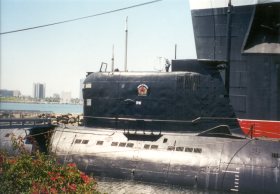
 |
| Here is the submarine, with the bow of the Queen Mary in the background. |
There is a Cold-War-era Russian submarine on display next to the Queen Mary in Long Beach, California. It is the Scorpion, and is a representative of the former Soviet Union's Foxtrot-class diesel-electric attack submarines. It was built in 1972, and performed active duty until 1994. The Queen Mary web site has a brief history of the submarine and a fact sheet which give some background information about the boat.
There is a short video presentation, which is a bit cheesy, but it talks a little bit about the history of the submarine. Most of it is a not-very-slickly-dramatized show of how submarines and surface ships hunt each other.
The tour is self-guided, and traverses the main deck of the boat from bow to stern. In each room, there were signs and speakers playing a recorded narration describing the function of each room. The narration was not bad as far as its content went, but the actor they hired to read the script sounded like he had learned his Russian accent from watching old episodes of Star Trek. Most of the time he sounded like Chekov, but some of the time he sounded more like Scotty. The effect was a bit disconcerting at times.
Anyway, it was an interesting tour, and it fit well with our hobby of collecting souveniers of the Cold War. So here are our pictures from the tour. Click on the picture for a larger view.
